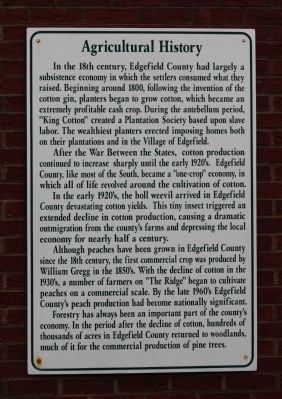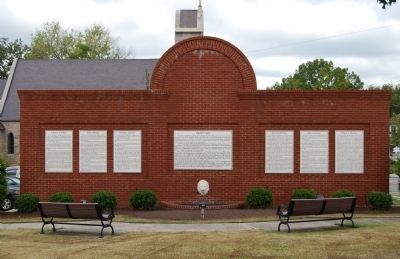Edgefield in Edgefield County, South Carolina — The American South (South Atlantic)
Agricultural History
In the 18th century, Edgefield County had largely a subsistence economy in which the settlers consumed what they raised. Beginning around 1800, following the invention of the cotton gin, planters began to grow cotton, which became an extremely profitable cash crop. During the antebellum period, "King Cotton" created a Plantation Society based upon slave labor. The wealthiest planters erected imposing homes both on their plantations and in the Village of Edgefield.
After the War Between the States, cotton production continued to increase sharply until the early 1920's. Edgefield County, like most of the South, became a "one-crop"economy, in which all life revolved around the cultivation of cotton.
In the early 1920's, the boll weevil arrived in Edgefield County devastating cotton yields. This tiny insect triggered an extended decline in cotton production, causing a dramatic outmigration from the county's farms and depressing the local economy for nearly half a century.
Although peaches have been grown in Edgefield County since the 18th century, the first commercial crop was produced by William Gregg in the 1850's. With the decline of cotton in the 1930's, a number of farmers on "The Ridge" began to cultivate peaches on a commercial scale. By the late 1960's Edgefield County's peach production had become nationally significant.
Forestry has always been an important part of the county's economy. In the period after the decline of cotton, hundreds of thousands of acres in Edgefield County returned to woodlands, much of it for the commercial production of pine trees.
Topics. This historical marker is listed in these topic lists: Agriculture • Horticulture & Forestry • Settlements & Settlers • War, US Civil. A significant historical year for this entry is 1800.
Location. 33° 47.4′ N, 81° 55.8′ W. Marker is in Edgefield, South Carolina, in Edgefield County. Marker is on Jeter Street, on the right when traveling west. Marker is located in the greenspace in the northwest corner of the intersection of Jeter and Bumcombe Streets. Touch for map. Marker is in this post office area: Edgefield SC 29824, United States of America. Touch for directions.
Other nearby markers. At least 10 other markers are within walking distance of this marker. A History of Violence (here, next to this marker); Political Heritage (here, next to this marker); The Name "Edgefield" (here, next to this marker); Industrial History (within shouting distance of this marker); Religion & Education (within shouting distance of this marker); Edgefield County (within shouting distance of this marker); First Term of Court (within shouting distance
of this marker); Edgefield County World War I Memorial (within shouting distance of this marker); Old Law Building (within shouting distance of this marker); Welcome to Historic Edgefield (within shouting distance of this marker). Touch for a list and map of all markers in Edgefield.
Also see . . .
1. Edgefield County Government. Official website of Edgefield County. (Submitted on October 9, 2010, by Brian Scott of Anderson, South Carolina.)
2. Edgefield County, South Carolina. Edgefield County is a county located in the U.S. state of South Carolina. (Submitted on October 9, 2010, by Brian Scott of Anderson, South Carolina.)
3. King Cotton. 'King Cotton' was a phrase used in the Southern United States mainly by Southern politicians and authors who wanted to illustrate the importance of the cotton crop to the Confederate economy during the American Civil War. (Submitted on October 9, 2010, by Brian Scott of Anderson, South Carolina.)
4. William Gregg. William Gregg (1800 – September 13, 1867) was an ardent advocate of industrialization in antebellum Southern United States. (Submitted on October 9, 2010, by Brian Scott of Anderson, South Carolina.)
5. Boil Weevil . The boll weevil (Anthonomus grandis) is a beetle measuring an average length of six millimeters, which feeds on cotton buds and flowers. (Submitted on October 9, 2010, by Brian Scott of Anderson, South Carolina.)
Credits. This page was last revised on January 23, 2020. It was originally submitted on October 16, 2008, by Brian Scott of Anderson, South Carolina. This page has been viewed 1,227 times since then and 18 times this year. Photos: 1, 2. submitted on October 16, 2008, by Brian Scott of Anderson, South Carolina.

